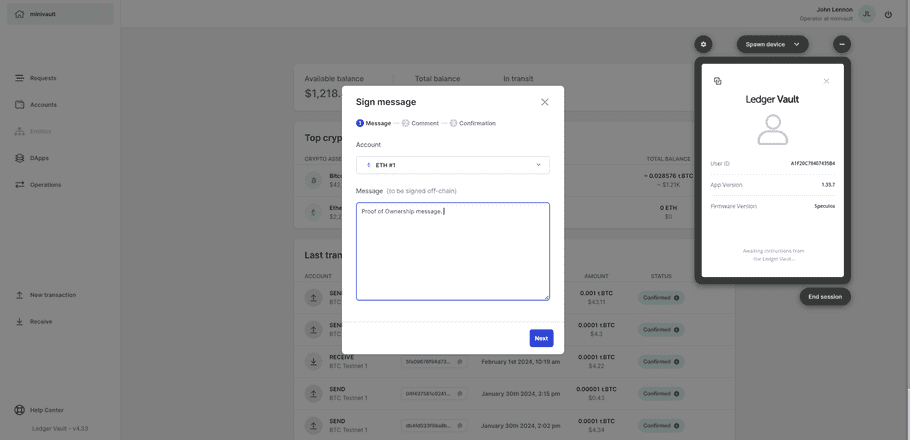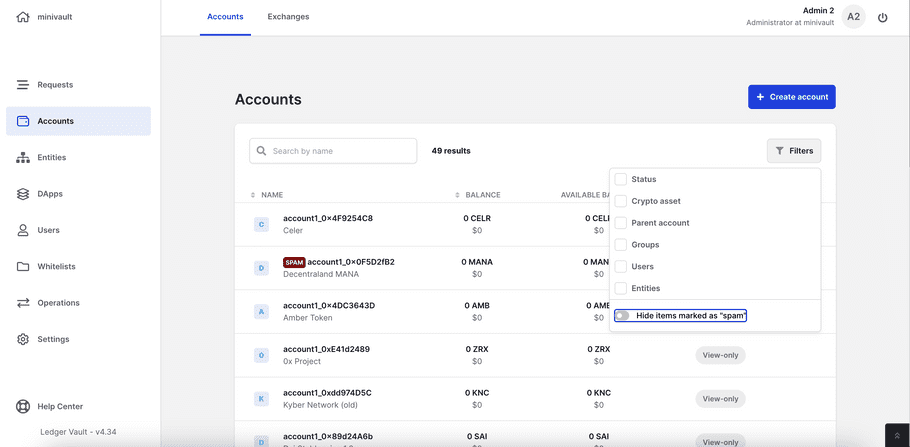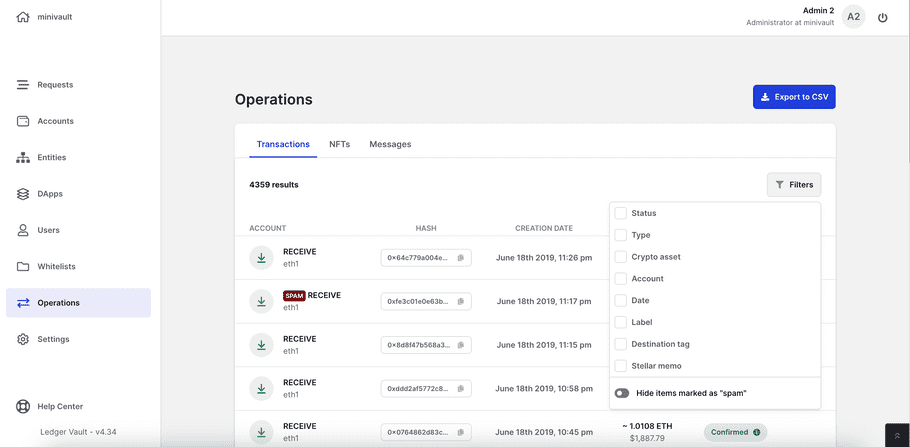What's new
Learn about the latest features and enhancements.
April 2025 - Tradelink edit Liquidity Provider and Asset Manager, Asset Manager pre-approval
April 2025 - Version 5.7.0
Tradelink Edit Liquidity Provider and Asset Manager
Tradelink users can now edit their exchange and Asset Manager objects from the Tradelink Dashboard. This means that Tradelink networks are much easier to scale for Custodians.
Asset Manager Pre-Approval
We’ve also added an extra governance rule to our collateral account flow. Now, you can toggle on the ability for an Asset Manager to be a part of the approval quorum when a Settlement needs to be approved. This can be done on a per exchange basis.
March 2025 - Tradelink edit Collateral account, Raw Signing public key (XPUB)
March 2025 - Version 5.6.0
Tradelink - Edit Collateral Account
Collateral accounts can now be edited at any time after creation. You can now add or remove exchanges or liquidity providers, change the automatic repledge rule and enable settlement pre-approval at any time.
Where to find your extended public key (XPUB)
You can now find your extended public key in Raw Signing accounts! Once a Raw Signing account has been created, an administrator can navigate to the account in the Vault UI, click on the Receive button the XPUB will be revealed.
February 2025 - Tradelink Automatic Repledge
February 2025 - Version 5.5.0
Tradelink Automatic Repledge
Tradelink users now have access to our new Automatic Repledge feature. This allows Asset Managers and Exchanges to configure Settlements in a way that means any profits moving from the Exchange to the Asset Manager are automatically added to the existing pledge between these two parties. This helps to increase trading efficiency, allowing both Asset Managers and Exchanges to focus on trading, not the manual operations surrounding trading.
Find more information here.
January 2025 - BASE support
January 2025 - Version 5.4.0
BASE support
We are excited to announce the addition of support for BASE Mainnet to the Ledger Vault. This new feature will allow clients to store and manage their BASE assets securely on the Ledger Enterprise Vault. BASE is a layer-2 scaling solution for Ethereum that offers faster transaction speeds and lower fees. With the addition of BASE support, the Ledger Vault continues in its endeavour to offer clients the widest range of assets possible.
December 2024 - EIP 1559, Tradelink Settlement, Withdrawal
December 2024 - Version 5.4.0
EIP-1559
We're excited to announce support for EIP-1559 transactions on the Ethereum network. This enhancement allows for more predictable transaction fees through an improved gas fee mechanism. With EIP-1559 support, your transactions can now include both a base fee and priority fee, helping to reduce overpayment and providing better fee estimation. This update streamlines the transaction process by automatically adjusting gas fees based on network demand, potentially leading to cost savings and faster confirmation times. You can now take advantage of this feature directly through your Vault workspace when sending Ethereum transactions.
Tradelink Settlement and Withdrawal flows
Settlement UI is creating a distinct Settlement approval flow for Asset Manager and Custodians when an exchange initiates a settlement. Traditionally, this looked like a regular transaction flow which could be quite confusing for these users when they were expecting a settlement.
Withdrawal is simply changing the nomenclature of transaction flows in collateral accounts so that it more closely aligns with nomenclature in trading institutions (from Send and Receive to Withdraw and Deposit).
November 2024 - Replace by Fee
November 2024 - Version 5.2.0
Replace by Fee
Ledger Enterprise users (operators) now have access to Replace by Fee (RBF) on the Bitcoin Network. RBF is a feature that lets you manage your Bitcoin transactions more efficiently. With RBF, you can replace an unconfirmed transaction in the Bitcoin mempool with a new transaction that includes a higher fee. This incentivizes miners to prioritize and confirm your transaction faster, especially during times of network congestion.
How to Use RBF To use RBF in the Vault, you have two options: "Boost" or "Cancel."
- Boost : Ideal when you have a pending transaction in the mempool and want to speed up its confirmation. By increasing the fee, you improve the chances of your transaction being processed quickly.
- Cancel : Use this option to attempt to cancel a transaction that hasn't been confirmed yet. You might need to do this to correct an error in the transaction details or if you decide not to proceed with the transaction. Please note that the Cancel feature is not guaranteed to work, as miners may still prioritize the old transaction over the new one.
For information on how these features work operationally, please refer to this page.
Automatic Logout and Session Refresh
We've enhanced the security and user experience of the Ledger Vault. Now, if a session expires due to inactivity, you'll be automatically logged out after 10 minutes. This helps protect the privacy of your Vault's content, prevents unexpected errors and ensures a smoother workflow. Additionally, a banner will appear one minute before your session expires, giving you the option to extend your session for another 10 minutes with a simple click. This will help avoiding an unexpected logout while working on a transaction for example.
Interface Updates
The Ledger Vault interface is being updated with new animations and icons to provide a more intuitive user experience. These updates also prepare the Vault for upcoming features, including Ledger Stax compatibility.
October 2024 - Raw Signing Feature Release
October 2024 - Version 5.1.0
Overview
We are excited to introduce the Raw Signing feature in Ledger Enterprise (ver. 5.1). This specialized feature allows API Operators to sign transactions on unsupported blockchains, enhancing flexibility in transaction management.
Key Highlights
- Use Cases: Sign transactions on unsupported blockchains, perform unsupported actions on supported chains, and prove messages on-chain.
- Access: Raw Signing is not included by default and is available upon request. Contact your Technical Account Manager (TAM) for eligibility.
Best Practices
To ensure secure usage, we recommend:
- Thoroughly validate transactions before submission.
- Limit access to trusted personnel.
- Regularly audit and monitor signing activities.
For more details on enabling and using Raw Signing, please refer to the documentation or reach out to your TAM.
June 2024 - Tradelink support
June 2024 - Version 5.0.0
Overview
We are excited to announce the latest Ledger Enterprise release which brings the support of Tradelink
- Tradelink is an open protocol standard to monitor, manage, pledge, and settle collateral balances secured and powered by Ledger Enterprise technology and hardware (HSM).
- Tradelink enables the creation of off-exchange trading as a service by offering a quick and easy way to set up the governance and access rights to accounts across multiple parties (multi-party governance). The Tradelink account multi-party governance defines the set of rules enforced on each party to authorize monitoring of collateral levels, creation, and approvals of collateral pledging and settlement.
Please read more about Tradelink here.
April 2024 - Proof of Ownership and Mark spam transactions enhancements
April 2024 - Version 4.34.0
Overview
We are excited to announce the latest Ledger Enterprise release (ver. 4.34), which brings following enhancements:
- Enhanced Compliance capabilities : sign Proof of Ownership messages on any network.
- Mark objects as spam : marking accounts and operations as spam and filter on them.
Enhanced Compliance capabilities: sign Proof of Ownership messages on any network
As a Ledger Enterprise user, you will now be able to define and use Message Signing capabilities across all supported networks. This enables you to sign Proof of Ownership messages, should you require it for Compliance purposes. Indeed, signing messages with a private key can be used to prove that an institution controls the private keys that correspond to its public addresses.
You can find out more about this feature in the dedicated spaces:
- for Admins : activate Message Signing on an account.
- for Operators : sign an EIP-191 compliance Message.

Mark objects as spam
As a Ledger Enterprise use (admin or oprator), you will now be able to mark/unmark an account or transaction as spam and then filter on this new tag. This is to reduce the risk that your operators accidentally use, in new operations, addresses from poisoning transactions. Note still that operators should always use the "receive" button to generate receive addresses safely, and not copy addresses from the operations history. Finally we strongly suggest to use whitelists systematically.
Please find more information on address poisonong scams here.
Process for marking accounts as spam:
Clicking on the button with the three dots "..." will display the context menu for you to mark or unmark an account as spam. You can find documentation for adding a label to the Account matching the ID here.
Please note that only "view-only" accounts can be marked as spam, meaning only LAM and API operators and all admins can mark accounts as spam.

Process for marking operations as spam:
Clicking on the button with the three dots "..." will display the context menu for you to mark or unmark an operation as spam. You can find documentation for adding a label to the transactions matching the ID here.

February 2024 - Enhanced API capabilities & Streamlining API user onboarding and authentication
February 2024 - Version 4.33.0
Overview
This release enables multiple API features on more granular bitcoin balances, the creation custom labels that can be used to flag transactions and accounts. We are also really proud to announce the upgrade of API operator onboarding and authentication for a streamlined API experience, please read more about this in Ledger Enterprise developer portal.
- Multiple API Improvements: We are proud to announce upgrades to our API operator onboarding and authentication processes, enhancing the overall API experience. For more details, please visit the Ledger Enterprise Developer Portal .
- Improved Balance Display on Bitcoin: Account balance details now include aggregated information on bitcoin Unspent Transaction Outputs (UTXOs). This update provides insights into whether UTXOs are currently in the mempool, in the process of confirmation, or finalized on the network. Additionally, it includes information on your dust and worthless amount, offering a more detailed overview of your Bitcoin holdings.
- Custom Labels via API: We are adding custom labels to transactions and accounts, allowing users to flag them for easier identification. Please note that this feature will be available via API and be added in the UI in a future update.